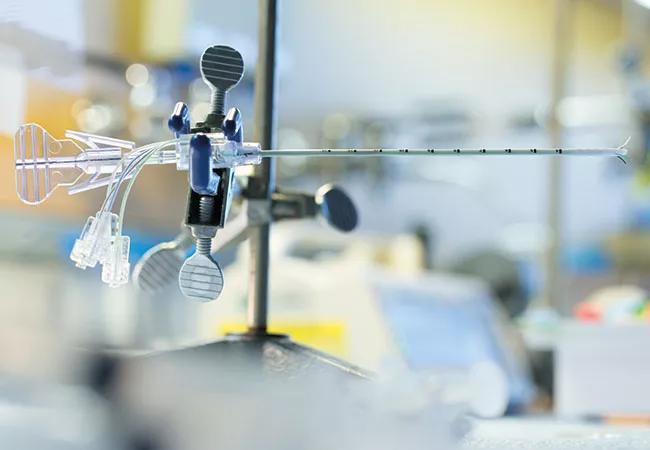Advertisement
Report from first-in-human study of new convection-enhanced delivery device

The Cleveland Multiport Catheter (CMC), a novel four-port device for convection-enhanced delivery, successfully conveys high volumes of chemotherapy to enhancing and nonenhancing regions of recurrent high-grade gliomas. So conclude Cleveland Clinic researchers who presented results from a clinical trial in the first 12 patients treated with the device at the 2017 annual meeting of the Society for Neuro-Oncology in San Francisco.
Advertisement
Cleveland Clinic is a non-profit academic medical center. Advertising on our site helps support our mission. We do not endorse non-Cleveland Clinic products or services. Policy
“Breaking through the blood-brain barrier is a continuing major challenge for delivering therapeutic drugs to fight brain cancers,” says Cleveland Clinic neurosurgeon Michael A. Vogelbaum, MD, PhD, the study’s lead investigator. “We are very encouraged to see that our catheter can effectively deliver around the blood-brain barrier in the setting of both solid and infiltrative brain tumors.”
Dr. Vogelbaum is Associate Director of the Rose Ella Burkhardt Brain Tumor and Neuro-Oncology Center and Director of the Center for Translational Therapeutics and Professor of Surgery at Cleveland Clinic Lerner College of Medicine. He is one of the inventors of the CMC and leads the Cleveland Clinic team testing the device. He is founder and chief medical officer of Infuseon Therapeutics Inc., a Cleveland Clinic-owned spinoff company that is funding clinical development of the CMC. Dr. Vogelbaum’s roles in this development effort are covered under a Cleveland Clinic-approved conflict-of-interest management plan.
The CMC was granted FDA clearance in March 2017 as a therapeutic delivery device. While convection-enhanced delivery (CED) has been in investigational use for about 20 years, no drug has yet received FDA approval for direct delivery into the brain parenchyma.
The CMC, developed at Cleveland Clinic in partnership with Cleveland-based multinational manufacturer Parker Hannifin Corp., has several advantages over similar devices under investigation for CED:
The CMC is surgically implanted and connected to low-rate infusion pumps. More details about the CMC are in this previous Consult QD post.
This study focused on recurrent high-grade glioma, a brain cancer that not only forms solid (enhancing) tumors but also grows in the brain in a highly infiltrative manner (nonenhancing), making it particularly resistant to radiation therapy and surgical excision. The study involved two pilot trials:
In both trials, two agents were delivered simultaneously through the CMC:
Advertisement
All 12 patients underwent successful placement of two CMCs each and completed infusions ranging from 48 to 96 hours. All catheters were placed with conventional operating room technology. MRI was performed intermittently during infusion.
Large differences were found in the volumes of distribution based on the site of delivery, with the highest volumes delivered to tumor-infiltrated regions (25-92 mL). No obvious backflow into the CMC shaft was observed intra- or perioperatively. No hemorrhages occurred during catheter placement or removal.
Dr. Vogelbaum’s team is currently recruiting patients for a third trial that will focus on optimizing the use of the CMC to deliver to the enhancing (solid) portion of recurrent tumors. They are also developing additional new devices for both short- and long-term delivery of therapeutics to the brain.
The CMC is not limited to delivery of chemotherapies. It is designed to be capable of delivering other biologic and cellular therapies to the brain, for brain tumors and also for other neurological conditions such as Alzheimer’s disease, Parkinson’s disease and epilepsy.
Dr. Vogelbaum notes that the CMC also could potentially be used to deliver therapeutics to solid tumors elsewhere in the body. Localized delivery could potentially avoid complications such as the bone marrow toxicity seen with typical systemic administration of many chemotherapies.
“The CMC has demonstrated excellent promise in our initial trials,” he says. “Successful localized and locoregional delivery is critical to treating brain tumors and a multitude of other conditions as well.”
Advertisement
Advertisement

Polygenic risk score could help predict who will develop this aggressive breast cancer

New guidelines offer insight into emerging therapies, dental issues and more

Clinical trial to assess the value of nutritional, physical therapy and social supports prior to preoperative chemotherapy

Research demonstrates improved overall survival for patients receiving comprehensive treatment for breast cancer in addition to radiation or surgical intervention for brain cancer

Platinum-eligible phase 3 trial of enfortumab vedotin and pembrolizumab yields ‘unprecedented data’

Cleveland Clinic Cancer Institute brings multidisciplinary care, precision oncology and clinical research to the United Arab Emirates

Extent of baseline burden impacts progression-free and overall survival

Further study warranted to better understand the clinical implications of these findings